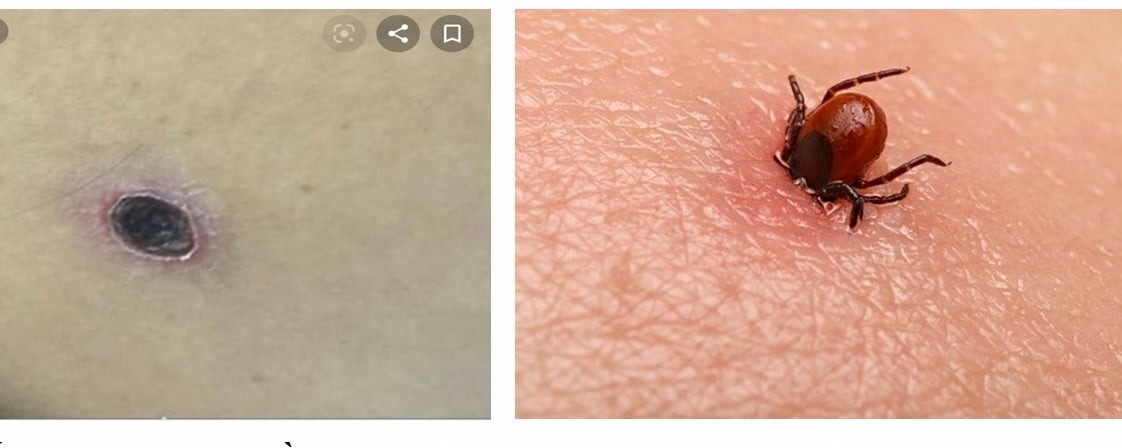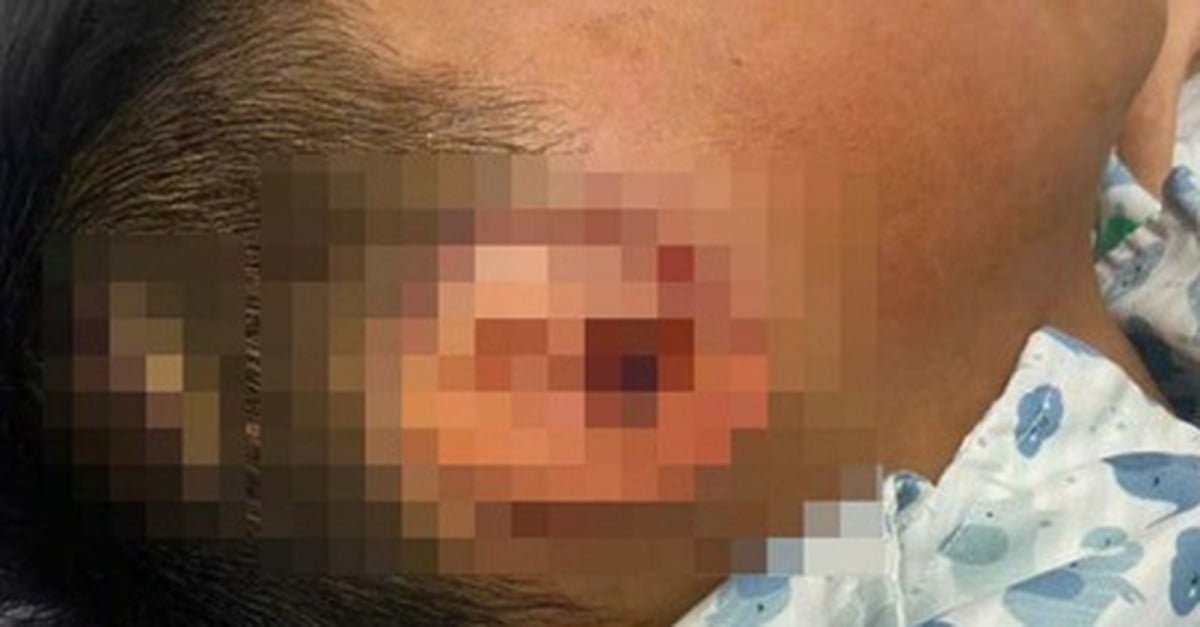The above case is an 18-year-old male patient from Vinh Phuc, who came to Medlatec General Hospital (Hanoi).
Talking to the doctor, the patient said that about 2 weeks before coming to the hospital, he had a high fever, 39 - 40 degrees Celsius, a rash appeared on his scrotum, then formed an ulcer, accompanied by painful lymph nodes in the left groin, headache, body aches and watery stools. The patient went to a medical facility near his home for examination, was diagnosed with a urinary tract infection, and prescribed antibiotics. However, after 5 days of taking the medicine, the symptoms did not improve.

Typical sores in a patient with scrub typhus (left) and image of a tick bite, which can transmit scrub typhus
At Medlatec General Hospital, directly treating the case, Dr. Tran Tien Tung, an infectious disease specialist, said that the patient had mild skin congestion, dry lips, 2 lymph nodes approximately 1 cm in size in the left groin area, slightly painful when pressed; the ulcer in the left subscrotum was approximately 1 cm in size, the base of the ulcer was pink, and there was no discharge. The patient was tested to differentiate it from other common infections. The patient's PCR test result was positive for Rickettsia that causes scrub typhus. Rickettsia is a family of obligate intracellular parasitic bacteria (living in cells). Based on the confirmed diagnosis and professional experience, the doctor prescribed medication to treat scrub typhus for the patient, and the patient's fever was completely gone after 3 days.
According to Dr. Ngo Chi Cuong, an infectious disease specialist at Medlatec Hospital, this is a case of high fever that has had its cause accurately identified and successfully treated. Because if not detected and treated promptly, tick fever can become severe and move to the brain and lungs, causing encephalitis and pneumonia.
Causes of scrub typhus
According to infectious disease experts, scrub typhus is also known as Rickettsia tsutsugamushi. The disease is transmitted to humans by lice, ticks, mite larvae, and fleas. In most patients with scrub typhus, ulcers are a typical sign of the disease.
Dr. Tran Tien Tung advises: If people have epidemiological factors and unusual ulcers appear on the skin, they need to be examined to diagnose whether the cause is scrub typhus or not. With scrub typhus, skin ulcers are a specific sign, usually oval in shape, 0.5 - 2 cm in size, with black scales or peeling off to form ulcers with edges, without secretion. The ulcers are usually painless, located in soft skin areas or folds such as armpits, chest, neck, groin, abdomen, scrotum... Cases diagnosed with scrub typhus need to adhere to a 14-day treatment regimen, because if you see symptoms of fever and stop treatment halfway, the disease is at risk of returning.
To prevent tick fever, you need to do the following: clear bushes around the house, remove weeds; spray insecticide to kill tick larvae; kill rats and rodents. When going into mountainous areas or areas with dense vegetation, you need to wear long pants, long-sleeved shirts, gloves, and cover your body. Do not lie on the grass or wet ground. Do not dry clothes on the grass to avoid tick larvae from sticking to them.
Scrub typhus (also known as tick-borne fever) is a disease transmitted to humans through an intermediate insect - the mite larva; the mite is both the host and the vector; people become infected when bitten by the mite larva. The infected person cannot transmit the disease to others.
The characteristic sores of scrub typhus often appear in soft, moist skin areas such as the genitals, anus, groin, armpits, neck, etc., sometimes in unexpected locations such as the earlobe, navel, or eyelids (easily mistaken for styes).
The ulcer is painless and not itchy; the patient usually has only one ulcer, rarely 2 - 3 ulcers; round/oval shape, 0.1 - 2 cm in diameter; the initial blister gradually develops into a cloudy fluid on a red papule base, after 4 - 5 days it ruptures into a ulcer with a light brown or dark brown crust depending on the skin area; after a while, the crust peels off to reveal a shallow, pale pink ulcer, no pus, no discharge.
Ulcers occur in 65 - 80% of cases. About 30% of patients with scrub typhus do not have characteristic ulcers.
If treated with appropriate antibiotics, fever will subside quickly. If intervention is delayed or ineffective, complications such as myocarditis, septic shock, pneumonia, respiratory failure, meningoencephalitis may occur. Recurrence usually occurs after 5 - 14 days because the pathogen still exists in the lymph nodes.
(Source: Department of Preventive Medicine, Ministry of Health)
Source link
















































Comment (0)